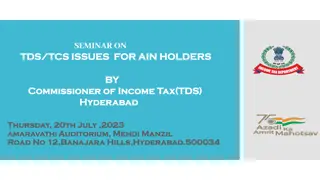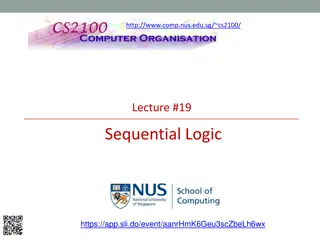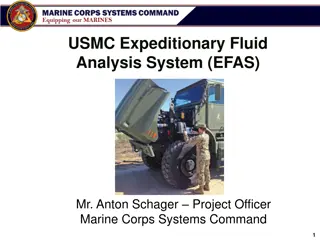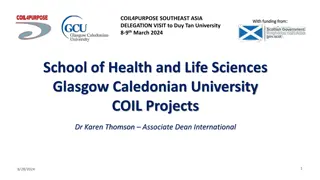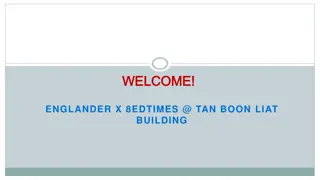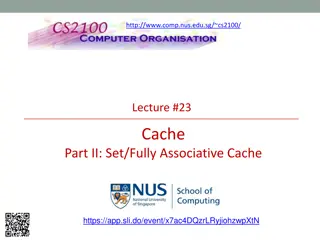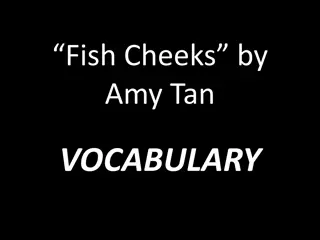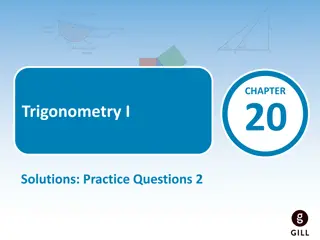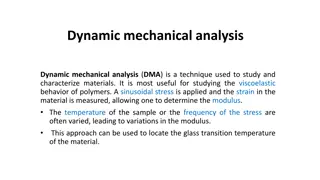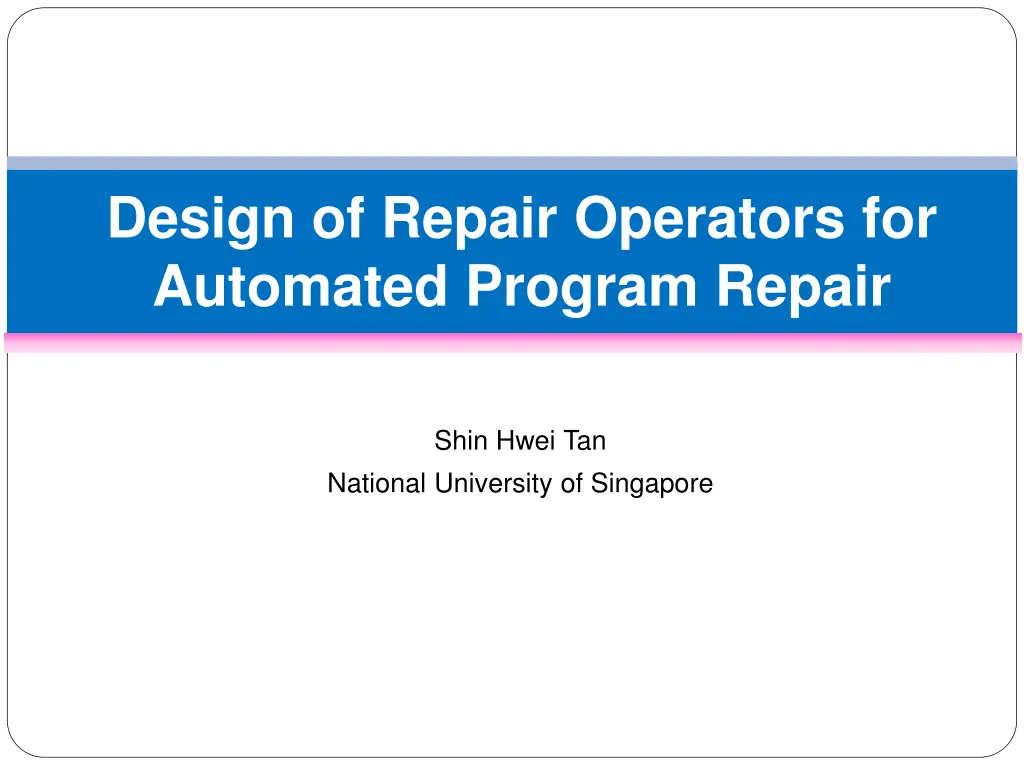
Automated Program Repair Techniques and Operators
Learn about automated program repair, including fault localization, patch generation, and patch validation using repair operators. Discover how to extract useful repair operators and types of software regressions. Explore the most frequently used operators in human repair for software issues.
Download Presentation

Please find below an Image/Link to download the presentation.
The content on the website is provided AS IS for your information and personal use only. It may not be sold, licensed, or shared on other websites without obtaining consent from the author. If you encounter any issues during the download, it is possible that the publisher has removed the file from their server.
You are allowed to download the files provided on this website for personal or commercial use, subject to the condition that they are used lawfully. All files are the property of their respective owners.
The content on the website is provided AS IS for your information and personal use only. It may not be sold, licensed, or shared on other websites without obtaining consent from the author.
E N D
Presentation Transcript
Design of Repair Operators for Automated Program Repair Shin Hwei Tan National University of Singapore
What is automated program repair? BUG! Given a failing Test T , buggy program P 1.Fault localization Where to fix? 2. Patch Generation using repair operators How to fix? 3. Patch Validation Are all tests passing?
How to extract useful repair operators? GenProg [ICSE '12] relifix [ICSE '15] Genetic Programming Random Local Search Search Mutations & crossovers Contextual Operators Operators Genetic Operators Human Repair of Software Regression & investigation of types of regressions Extracted from
Test 1 while (out > line) out; Test 2 Test 3 Regression! How to repair? Test 1 + -while (out > line) - out; out; Test 2 while (out > line) + Test 3 Regression Fixed!
Types of Software regressions Local Unmask + - + + - + Changes Changes -- -- Changes break existing functionality Repair: Roll back to previous version Changes unmasks existing bug Repair: Re-mask problematic change Remote formulate the software regression repair problem as problem of reconciling problematic changes + - + Changes -- Changes introduce bug in other unchanged parts Repair: Re-mask problematic change
Most frequently used Operators in Human Repair Operator Operator Type Count Add condition Add statement Use changed expression as input for other operator Revert to previous statement Replace with new expression Remove incorrectly added statement Change type Add method Add parameter Add local variable Swap changed statement with neighbouring statement Negate added condition Convert statement to condition variable statement Add field Total Non-contextual Non-contextual Contextual Contextual Non-contextual Contextual Non-contextual Non-contextual Non-contextual Non-contextual Contextual Contextual Contextual Non-contextual 6 Contextuals 27 21 13 11 13 9 5 5 4 3 2 1 1 1 116
Contextual Operators Use changed expression as input for other operator - if (((f = lookup_file (p)) != 0 && f->is_target) + if (((f = lookup_file (p)) != 0 && (f->is_target || intermed_ok)) Revert to previous statement - /* Removing this loop will fix Savannah bug #16670: - do we want to? */ - while ( out > line && isblank (( unsigned char ) out[-1])) - --out ;
Experimental Results Evaluated on 7 open source projects relifix repairs 23 bugs, GenProg only fixes five bugs relifix is less likely to introduce new regressions than GenProg Related questions: How about regression in automatically generated patches? How to avoid Regression Introducing Patches?
Search-Based Program Repair Final Patch Search-Based Repair Tools Tests Fail How do the tests look like? All Tests Pass Patch Generation Tests contains at least one failing test Candidate Patches How do the patches look like? Patch Evaluation
Search-Based Program Repair Test Script $command $argument1 $argument2 RETVAL=$? [ $RETVAL -eq 0 ] && echo Success [ $RETVAL -ne 0 ] && echo Failure Check exit status of command Non-zero exit status denotes test failure Tests Candidate Patches - exit(-2); Patch Evaluation
Repair patterns from human patches Human patches Automatic Program Repair int foo(){ + if(input1) + return(out1) //compute something } Conditional Control Flow: +if(a) + return b; that can be enforced on top of any search-based repair tool. Anti-patterns Set of generic forbidden transformations
Problem: Weak Oracle Failing Test Script $command $argument1 $argument2 RETVAL=$? [ $RETVAL -eq 0 ] && echo Success [ $RETVAL -ne 0 ] && echo Failure Test outcome determined by exit status Statements like exit call/assertions serve as test proxies Test proxies should not be randomlymanipulated A1: Anti-delete CFG exit node Remove return statements, exit calls, functions with the word error , assertions. static void BadPPM(char* file) { fprintf(stderr, "%s: Not a PPM file.\n", file); - exit(-2); }
Problem: Inadequate Test Coverage Repair tools allow removal of code as long as all test passes Statements are mistakenly considered as redundant code Anti-patterns: A2: Anti-delete Control Statement A3: Anti-delete Single-statement CFG A4: Anti-delete Set-Before-If A2: Anti-delete Control Statement Remove control statements (e.g., if-statements, switch- statements, loops). call_result = call_user_function_ex(...); - if (call_result == SUCCESS && ...) { - if (SUCCESS == statbuf_from_array(...)) - ret = 0; - } else if (call_result == FAILURE) {
Problem: Non-termination Automatically generated patches may incorrectly removes loop update Cause infinite loop A5:Anti-delete Loop-Counter Update Remove assignment statement A inside loop L if: ??? ?? ??????????? ????????? ?? ? {??? ?? ??? ?? ?????????? ?} = while( x> 5) - x++;
Problem: Trivial Patch Trivial patch patch that insert return-statements based on expected output Ex: +if(test1) + return out1 A6: Anti-append Early Exit Insert return/goto statement at any location except for after the last statement in a CFG node. + if ((type != 0)) + return; zend_error((1<<3L),"Uninitialized string offset:",...);
Problem: Functionality Removal Removes functionality by inserting T/F A7: Anti-append Trivial Conditions Insert trivial condition. A condition is trivial if and only if it is: 1) True/False Constant 2) Tautology/Contradiction in expression (e.g., if(x || y || !y)) 3) Static analysis (e.g., if(x || y != 0), y is initialized) - if ((fmap[j].key != format->ptr[i + 1])) + if ((fmap[j].key != format->ptr[i + 1]) && !(1)) continue;
Integrating Anti-patterns Final Patch Search-Based Repair Tools Tests Fail Patch Generation All Tests Pass Candidate Patches Tests contains at least one failing test Is Anti-pattern? Patch Evaluation YES NO
How could anti-pattern helps? Evaluated on 12 open source projects Enforcing anti-patterns leads to patches with better fix localization and delete less functionality. Tools integrated with anti-patterns generate patches faster due to repair space reduction. Related questions: Are existing program repair techniques effective in generating patches? Anti-patterns reveal many problems in automatically generated patches How about anti-patterns for repair operators? Could we get rid of repair operators that are ineffective?
Design of Repair Operators: Codeflaws Programming Competition Benchmark for Objective Evaluation of Program Repair
Codeflaws Benchmark Obtained from Codeforces online database Diverse types of defects 40 defects types Large number of defects 4085 real defects Large number of programs 7945 programs Large Held-out test suite for patch validation 5-350 tests, Average: 40 Non-trivial programs (algorithmically complex) Support large-scale controlled Experiments https://codeflaws.github.io/
Frequency and Effectiveness of Repair Operators GenProg SPR Freq(%) Eff(%) Freq(%) Eff(%) Repair Operator Prophet Freq(%) Angelix Freq(%) Eff(%) Eff(%) Delete Statement Insert Assignment Insert If Loosen /Tighten Condition Variable Replacement Relational Operator Replacement 17.53 41.22 17.39 38.46 5.77 43.10 4.80 39.51 16.92 38.74 7.96 54.53 50.00 22.35 5.96 3.12 32.56 4.44 46.06 19.95 8.51 56.73 6.46 29.36 19.42 0.36 31.07 42.41 High frequency, Low Effectiveness
Future Research Applications of Program Repair Test-Driven Merging Instead of using Longest Common Subsequence, use tests to drive merging of multiple programs Provide additional guarantee that merged program pass all tests Anti-patterns beyond Program Repair Anti-patterns as specification for guiding repair Anti-patternsas selected code smells Adapt anti-patterns to other search-based software engineering activities (e.g., specific code anti-patterns identifying energy hot-spots)


